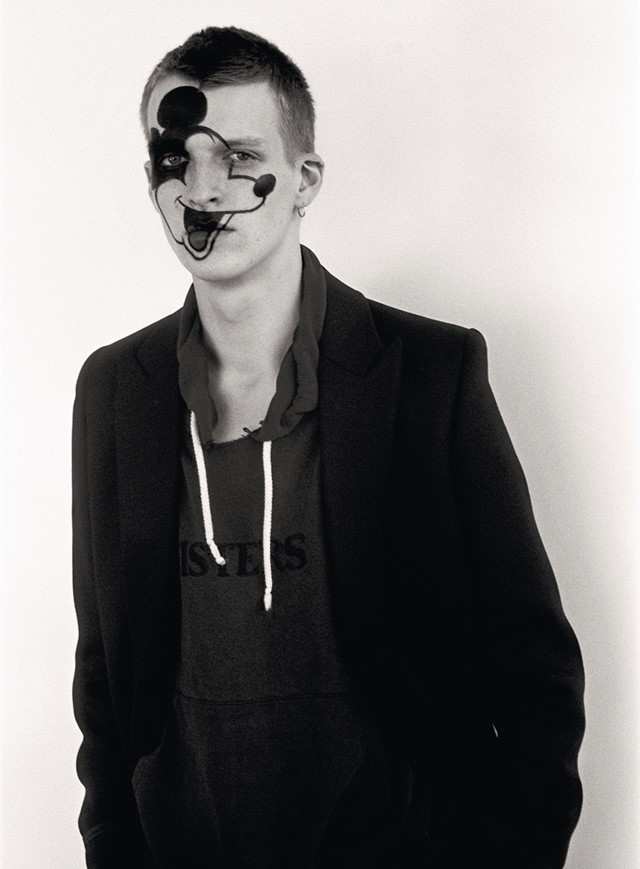Continuing our Insiders muse special, we meet Raf Simons' favourite, Robbie Snelders
In 1998, a 20-year-old Robbie Snelders was just another moody, serious tattooed youth living in Antwerp listening to industrial music and going to techno clubs; in other words the real life personification of the subculture that Raf Simons presented in his early work. “I came from a small town outside Antwerp so I wasn’t really aware of fashion,” recalls Snelders. “I was just living with my then girlfriend, struggling but happy.” Picked to try out for a fashion show by the then emerging menswear designer, Snelders turned up to the casting “in army trousers and Doc Martens so I didn’t think Raf had a good impression of me the first time.” But they hit it off immediately, bonding over a love of the same bands and dark club music. Snelders started off working in Simons’ showroom before making his runway debut in his incendiary Black Palms show. Resembling a post punk David Bowie, Snelders would become a muse and sometimes surrogate for the then-press averse designer, embodying the aesthetic that felt so personal to him. “With the first show I did for Raf, it was forty of us guys going on a bus to Paris. For most people, male models meant Marky Mark and this was something completely different. They didn’t understand what these skinny, pale, 60kg guys were doing in Paris for a show but then you saw it and it made sense.”
"I came from a small town outside Antwerp so I wasn’t really aware of fashion"
Taking the Mickey Out of It
Through Simons, Snelders started working together with stylist Olivier Rizzo, make-up artist Peter Phillips and photographer Willy Vanderperre – all recent graduates of the Royal Academy of Fine Arts – going on to create some of the most arresting imagery of those times, none more iconic than the stark black and white portrait taken by Vanderperre with a Mickey Mouse face paint by Phillips. “When we did that shoot, it was just in their apartment, there was no studio involved – basically just four people and that was it. Peter had this idea that he wanted to try out. I didn’t know what he was doing because I wasn’t looking at myself, I was making jokes all the time and I ended up with a Mickey Mouse on my face. Olivier just threw one of Raf’s jackets over it and we took the picture. It wasn’t meant to be published, but then suddenly it was everywhere.” Originally used as the cover for the nascent style magazine V’s inaugural issue, it later became the main image of the 2003 exhibition on youth’s extremes, ‘The Fourth Sex’ curated by Simons and Francesco Bonami which mashed together David Lynch, Bret Easton Ellis, Gavin Turk and JG Ballard. “When it was used for the exhibition, I was a bit more embarrassed than proud,” he admits. “But I remember walking into that exhibition and through that book I learnt so many things. I don’t want to call it a bible, but everyone should have it because you always discover things in it.”
"High fashion was never something for me. I don’t feel connected to it anymore"
Raf Simons Redux
“Looking back, I didn’t start anything,” protests Snelders, “It was working with the right people at the right time. At that time, I spent most of my days wondering how to dress and how to act and what gigs to go to, going to discos and not having any sleep. So I think that was inspiring for them. They would look at what I wore, extract a small part of it and make it fashion. Raf has this gift for picking up on things from everywhere and turning them into something else.” Fifteen years later, the outsiders are now at the forefront of the fashion industry with Simons acclaimed as the most influential menswear designer in the industry and now creative director of Dior, Phillips in charge of Dior make-up, and Vanderperre and Rizzo still collaborating but now on campaigns for Prada, Dior and Miu Miu. So where does it find Snelders? Still living in Antwerp, “still wearing a bomber jacket, and Dr. Martins. I never evolved!” laughs Snelders wryly who still takes on the odd modelling job or editorial. “I’m proud of them, but it’s a different world now. High fashion was never something for me. I don’t feel connected to it anymore.”
Yet the rawness of the images of Snelders still acts as a beacon for a generation of fashion fans, a potent antidote to the prevailing musclebound aesthetic of the Nineties. It was a specific moment in time – a testament to youth, fleeting but now forever enshrined. It resonates so much precisely because of what it conveys – suburban isolation, the freedom and defiance of youth, the acute sense of brotherhood and family. Maybe Simons put it best in the foreword to his 2005 monograph ‘Raf Simons Redux’ celebrating a decade in fashion, “Raf Simons, as the world knows the label, is not me. Or better: not solely about me. It has always been, and will always continue to be, about us, about we, about you.”
Words by Kin Woo
